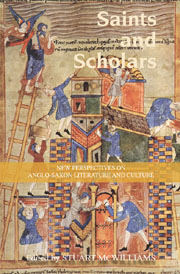 Saints and Scholars
Saints and Scholars Book contents
- Frontmatter
- Contents
- List of Contributors
- Abbreviations
- Introduction
- I Hagiography and the Homiletic Tradition
- 1 A Note on the Sensational Old English Life of St Margaret
- 2 A Place to Weep: Joseph in the Beer-Room and Anglo-Saxon Gestures of Emotion
- 3 Aldhelm's Choice of Saints for his Prose De Virginitate
- 4 Shepherding the Shepherds in the Ways of Pastoral Care: Ælfric and Cambridge University Library, MS Gg.3.28
- 5 “Consider Lazarus”: A Context for Vercelli Homily VII
- 6 More than a Female Joseph: The Sources of the Late-Fifth-Century Passio Sanctae Eugeniae
- 7 Ælfric, Leofric and In Natale Plurimorum Apostolorum
- II Aspects of Community and Consumption
- III Reflections on Old English Scholarship
- Poems
- Hugh Magennis: A Bibliography, 1981–2011
- Index
- Tabula Gratulatoria
6 - More than a Female Joseph: The Sources of the Late-Fifth-Century Passio Sanctae Eugeniae
from I - Hagiography and the Homiletic Tradition
Published online by Cambridge University Press: 05 February 2013
- Frontmatter
- Contents
- List of Contributors
- Abbreviations
- Introduction
- I Hagiography and the Homiletic Tradition
- 1 A Note on the Sensational Old English Life of St Margaret
- 2 A Place to Weep: Joseph in the Beer-Room and Anglo-Saxon Gestures of Emotion
- 3 Aldhelm's Choice of Saints for his Prose De Virginitate
- 4 Shepherding the Shepherds in the Ways of Pastoral Care: Ælfric and Cambridge University Library, MS Gg.3.28
- 5 “Consider Lazarus”: A Context for Vercelli Homily VII
- 6 More than a Female Joseph: The Sources of the Late-Fifth-Century Passio Sanctae Eugeniae
- 7 Ælfric, Leofric and In Natale Plurimorum Apostolorum
- II Aspects of Community and Consumption
- III Reflections on Old English Scholarship
- Poems
- Hugh Magennis: A Bibliography, 1981–2011
- Index
- Tabula Gratulatoria
Summary
Among the most successful and long-lasting of Christian literary genres to emerge in late Antiquity was the passio (or acta or gesta) narrating a martyr's arrest, interrogation, suffering and execution. A handful of such works – including the Passions of St Perpetua and St Felicity, Bishop Polycarp, and the Martyrs of Lyon, along with the so-called Proconsular Acts of St Cyprian, to name the best known – are believed to have been composed during the age of persecution itself, the first three centuries ad, by eye-witnesses or by others with access to trial records. These few early passiones form a special category of the genre, labelled ‘passions historiques’ by their pre-eminent modern critic, the Bollandist Hippolyte Delehaye. After official persecution ended, and especially with the promotion of the cult of martyrs and their relics in the fourth and fifth centuries, dozens of other martyrs' passiones were composed in Greek or Latin in various parts of the Christian Empire. Some of the Greek passions, in Latin translation, and many of the Latin passions originating in Rome itself, became popular in religious communities across Europe in the early Middle Ages and later, to judge from the surviving martyrologies and the abundant manuscript remains of the passiones themselves.
While the so-called historical martyrs' passions have been edited and studied frequently in the modern era, historians and philologists have mainly ignored the later passiones, which Delehaye and Aigrain have labeled ‘les passions épiques’ and ‘passions romanesques’, with their more sensational, miracle-filled and typically ‘hagiographical’ content; and because they are presumed to be largely forgeries and fiction, except for the names of the martyrs themselves (and not all of these are genuine).
- Type
- Chapter
- Information
- Saints and ScholarsNew Perspectives on Anglo-Saxon Literature and Culture in Honour of Hugh Magennis, pp. 87 - 111Publisher: Boydell & BrewerPrint publication year: 2012


